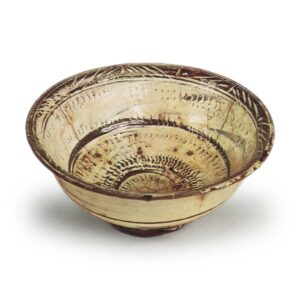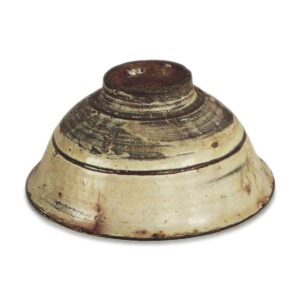

Height: 6.4-6.9cm
Diameter: 14.6-14.8cm
Outer diameter of foot ring: 4.7-4.9cm
Height of foot ring: 1.1cm
The accompanying note on the tea bowl says: “The Futoku Mishima is the best tea bowl in the world, and was owned by the tea master Rikyu. The inscription on the tea bowl says, “The old Mishima tea bowls of the Unshu family’s Takeda Mishima and the Osaka-based Tamaya Mishima are both of a very high quality, and there are no other bowls that can compare with them. The Inaba family’s Oshima tea bowls have a crack in the old style, and there are none like the old Mishima tea bowls. The old Mishima tea bowls are the best in the world. The inscription tells us that the tea bowl was owned by the tea bowl maker Futagami. Furthermore, it is also said that Sen no Rikyu owned it before Nitoku, but according to the “Nanbokuroku”, Rikyu used two Mishima tea bowls at his own meetings, and one of them is known as the “Mishima-tsubo”, and the other is known simply as “Mishima”. Therefore, if we believe the tradition that this tea bowl was owned by Rikyu, it is thought to be the same “Mishima” tea bowl that was used on four occasions: October 3rd, November 17th, December 22nd, and February 3rd of the 15th year of the Tensho era. Incidentally, the first tea gathering on October 3rd, as described in the “Nanbokuroku”, was
October 3rd, from dawn, two tatami mats, Hosokawa (Yusai), Tsuge (boxwood) Sakyo
First, one bundle of ink marks, one line of light, one kettle with a threaded handle, one shelf with two rings (silver), one camellia, one charcoal container, one incense container,
(omission)
After that, there is a roll of futon, two chiku-bari bamboo tubes with chrysanthemums, a tea container, a small jujube, a tea bowl, a Mishima tea bowl, a small water jug, and a pair of birds on a branch.
The Mishima tea bowl is used in combination with a small, lacquered tea container, and this arrangement is the same as that used on November 17th, and it is a taste that is very much like that of Rikyu, and it seems to be an arrangement that is suitable for the tea bowl.
Among the Korean tea bowls, it is thought that Kosan, Hakeme, Kohiki and Ido were used for tea ceremonies from relatively early on, and must have been imported in large numbers, but surprisingly few of the Kosan tea bowls that have survived are genuine old pieces, and even in the Taisho Meiki Kan (A Guide to Famous Tea Bowls from the Taisho Period), the number of genuine old Kosan tea bowls is limited to six, including the Reihin San , and even if we add the “Takeda Mishima” owned by Lord Fumai and the “Mishima Cup” that came from the Tamaya family, it is still a paltry number compared to the number of Ido tea bowls, and it can be seen how few Mishima tea bowls there are that are worthy of being called famous bowls from ancient times.
The slightly The slightly turned-up rim, the small, tight foot, and the smooth curve of the body are all unique to Kosan, and the inside of the body is decorated with two lines of incised lines, one running down the middle of the body and the other running down the center of the middle of the body, with the famous calendar-shaped incised pattern in between. A generous amount of white powder is sprinkled on top of this. On the outside only has two lines of incised lines around the waist and around the foot of the rim, and from the rim to the foot of the rim, it is also thickly brushed with white, but the foot of the rim and the waist are brushed thinly, revealing the grayish-brown surface. The transparent glaze applied inside and out melts well with a good thickness, and the glaze has an indescribable softness. The glaze pool in the interior The glaze pool is slightly yellowish, and the stains on the inside and outside are also pleasingly deep.
Rikyu , it is not known exactly when it came into the possession of the Mitsui family of Kyoto, but it was passed on to the Kyoto governor, Lord Sakai Tadayoshi, at the end of the Edo period, along with the Teika kaisi, for 3,000 ryou. In June 1923, when the Sakai family put it up for auction, it was bought by the Mitsui Haraemon family for 76,200 yen, and it has remained in their possession to this day. Shunkei



